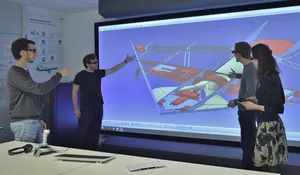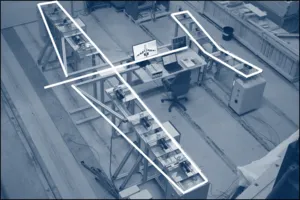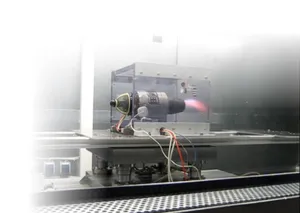Virtual Reality Lab
For advanced simulations of aircraft designs as well as for educational purposes, a virtual reality wall (VR wall) is installed at the Chair of Aircraft Systems. The VR wall consists of 6 laser light engines that produce an image with a resolution of 4000 x 2000 pixels, the total size of the image is 4.30 m x 1.80 m. The virtual reality wall works as a monitor and can be connected to a workstation via a special pixel processor. With a powerful graphic card in the computer, a 3D model can be visualized and simulated on the VR wall. Visualizing complex relationships together with the ability to display large amounts of information simultaneously allows a deeper understanding of the design process.
Iron Bird
Thanks to modern computer aided design and simulation tools, aircraft systems are being steadily improved. However, to ensure that reliability and performance requirements of the on-board systems are met, additional testing with the actual hardware is needed. The Iron Bird Test Facility offers a test environment for evaluating the functionality of the flight control system, avionics bus systems and the power distribution network amongst others. Dedicated electromechanical equipment allows for Hardware-in-the-Loop tests under specified conditions and recording of a wide range of operational parameters at high sampling rates.
Goals:
- Support the design and integration of on unmanned aerial vehicle research demonstrator aircraft
- Prepare unmanned aircraft for the implementation of novel aircraft system architectures
- Ensure functional and reliability specific requirements are met
UAV Engine Test Lab
Propulsion systems and their integration into unmanned aerial vehicles represent a key competence in the development of novel system concepts. With the support of the Bavarian State Ministry of Economics and Media, Energy and Technology, the Chair of Aircraft Design has created a unique test facility that can be used to power UAV drives from electrical systems to power systems towards micro-turbojet engines can be measured. The extensive sensor equipment also allows the development of shear vector systems. For the first time, the test bed was used during the SAGITTA project for the evaluation and optimization of the propulsion system. With a detailed test campaign, the complex inlet geometry as well as innovative nozzle concepts were tested and further improved. Currently, the test bench is available for engine tests for the FLEXOP project, as well as for measuring the influence of fuselage components on the propeller thrust of vertically-launched UAV configurations.


